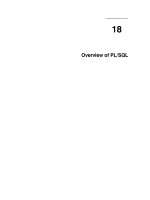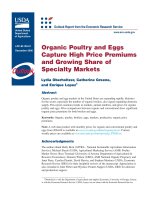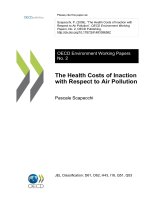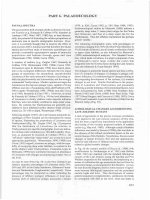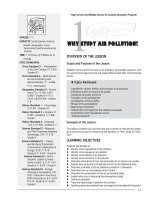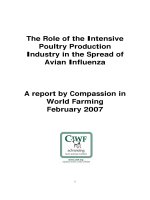Forest Health & Biosecurity Working Papers: OVERVIEW OF FOREST PESTS pptx
Bạn đang xem bản rút gọn của tài liệu. Xem và tải ngay bản đầy đủ của tài liệu tại đây (244.92 KB, 47 trang )
Forestry Department
Food and Agriculture Organization of the United Nations
Forest Health & Biosecurity Working Papers
O
VERVIEW OF FOREST PESTS
T
HAILAND
January 2007
Forest Resources Development Service Working Paper FBS/32E
Forest Management Division FAO, Rome, Italy
Forestry Department
Overview of forest pests – Thailand
ii
D
ISCLAIMER
The aim of this document is to give an overview of the forest pest
1
situation in Thailand. It is not
intended to be a comprehensive review.
The designations employed and the presentation of material in this publication do not imply the
expression of any opinion whatsoever on the part of the Food and Agriculture Organization of the
United Nations concerning the legal status of any country, territory, city or area or of its
authorities, or concerning the delimitation of its frontiers or boundaries.
© FAO 2007
1
Pest: Any species, strain or biotype of plant, animal or pathogenic agent injurious to plants or plant products (FAO, 2004).
Overview of forest pests – Thailand
iii
T
ABLE OF CONTENTS
Introduction 1
Forest pests 1
Naturally regenerating forests 1
Insects 1
Diseases 3
Other pests 3
Diebacks and other conditions 4
Planted forests 4
Insects 4
Diseases 20
Other pests 23
Diebacks and other conditions 24
Capacity for forest health protection 24
Government level 24
Monitoring and detection 24
Data management 24
Pest management 24
Private landowners 24
References 24
Index 25
Overview of forest pests – Thailand
iv
Background
This paper is one of a series of FAO documents on forest-related health and biosecurity issues.
The purpose of these papers is to provide early information on on-going activities and
programmes, and to stimulate discussion.
In an attempt to quantify the impacts of the many factors that affect the health and vitality of a
forest, the Global Forest Resources Assessment 2005 (FRA 2005) asked countries to report on the
area of forest affected by disturbances, including forest fires, insects, diseases and other
disturbances such as weather-related damage. However, most countries were not able to provide
reliable information because they do not systematically monitor these variables.
In order to obtain a more complete picture of forest health, FAO continues to work on several
follow-up studies. A review of forest pests in both naturally regenerating forests and planted
forests was carried out in 25 countries representing all regions of the world. This Overview of
forest pests represents one paper resulting from this review. Countries in this present series
include Argentina, Belize, Brazil, Chile, China, Cyprus, Colombia, Ghana, Honduras, India,
Indonesia, Kenya, Kyrgyz Republic, Malawi, Mauritius, Mexico, Moldova, Mongolia, Morocco,
South Africa, Sudan, Thailand, Romania, Russian Federation, Uruguay; this list will be
continuously updated.
Comments and feedback are welcome. For further information or if you are interested in
participating in this process and providing information on insect pests, diseases and mammals
affecting forests and the forest sector in your country, please contact:
Gillian Allard
Forestry Officer (Forest Protection and Health)
Forest Resources Development Service
Forest Management Division
Forestry Department
FAO
Viale delle Terme di Caracalla
00153 Rome, Italy
Telephone: +39 06 570 53373
Fax: + 39 06 570 55137
E-mail:
All contributions will be fully acknowledged.
Acknowledgements
Information for Thailand was compiled by B. Moore.
Overview of forest pests – Thailand
1
T
HAILAND
Introduction
Thailand is moderately forested, although its forest cover has roughly halved since 1960.
Of Thailand’s 51 million hectares of land, 14.5 million hectares, or 28 percent, are
forested (FAO, 2006). Most of the forests are restricted to relatively inaccessible
mountainous areas. The main forest types are evergreen montane rain forest; mixed
deciduous monsoon forest; and open dry dipterocarp and savannah forests. Dipterocarpus
spp., Shorea spp. and Hopea spp. are among the most prevalent species. Teak (Tectona
grandis) has generally been the most important timber species.
The country has about 3.1 million hectares of planted forests (about half of which are
rubber plantations) representing over 21 percent of the total forest area (FAO, 2006). A
network of parks and reserves encompasses more than 10 percent of the total land area.
By 1999, 56 percent of the existing forest areas had been declared national conserved
forests.
Thailand’s forest resources have been subjected to continuing pressure and devastation.
Between the 1960s and the 1980s, forest resources were reduced by shifting cultivation,
land resettlement, dam and road construction and conversion to agricultural use. Demand
for land for subsistence farming, commercial agriculture, physical infrastructure, tourism
and other uses remains high.
Thailand banned all commercial logging in naturally regenerating forests in 1988 and has
instituted supporting measures to protect the remaining forests and to promote private-
sector involvement in forest management and plantations. Nevertheless, deforestation and
forest degradation have continued, and efforts to combat forest loss remain a leading
issue in the country. From 2000 to 2005 forest cover decreased at an annual rate of 0.4
percent, down from 0.7 percent between 1990 and 2000 (FAO, 2006).
Reforestation has been practiced in Thailand since the beginning of the twentieth century,
when teak was planted in taungya plantations, but only small areas were planted annually
until the reforestation programme was expanded in 1961. In 1988, the country undertook
an accelerated reforestation programme after devastating floods destroyed two villages.
During the mid-1990s, Thailand initiated various programmes to reforest 800 000 ha.
Because of budgetary constraints, land-use conflicts and various structural impediments,
the target has not been reached.
Forest pests
Naturally regenerating forests
Insects
Indigenous insects
Eutectona machaeralis Walker, 1859
Other scientific names:
Overview of forest pests – Thailand
2
Lepidoptera: Pyralidae
Common names: teak skeletonizer; teak leaf skeletonizer
Host type: broadleaf
Hosts: Tectona grandis
Eutectona machaeralis is a major pest of teak, occurring throughout South Asia and some
parts of Southeast Asia. Complete defoliation by the pests results in more or less
leaflessness during most of the growing period.
Outbreaks of this species occur in most years with exceptionally heavy build-up in some
years. Although the insect is present throughout the year, outbreaks develop towards the
end of the growing season before normal leaf shedding (Nair, 2001).
/>SpID=1603
Hyblaea puera (Cramer, 1777)
Other scientific names: Phalaena puera; Noctua saga; Noctua unxia; Heliothis apricans
Lepidoptera: Hyblaeidae
Common names: teak defoliator
Host type: broadleaf
Hosts: Alstonia scholaris; Avicennia spp.; Callicarpa spp.; Pterocarpus macrocarpus;
Rhizophora spp.; Tectona grandis; Vitex spp.
The larvae of this moth species feed on the leaves of a wide range of plants including
Avicennia spp., Callicarpa spp., Rhizophora spp., Vitex spp. and Tectona grandis. In
Thailand, it is a pest of Alstonia scholaris, Pterocarpus macrocarpus and Tectona
grandis. It is considered to be a major pest of teak plantations in areas of Asia.
The larvae create shelters for themselves by cutting pieces of leaves and rolling them
together. They come out of the shelters to feed by night. Hyblaea puera is widespread
throughout the tropics occurring in Asia, Australia, the Pacific Islands, Africa, Central
America and South America.
Xyleutes ceramica Walker
Other scientific names: Zeuzera ceramica; Duomitus ligneus; Eudoxyba bosschae
Lepidoptera: Cossidae
Common names: beehole borer; teak beehole borer
Host type: broadleaf
Hosts: Callicarpa spp.; Clerodendrum spp.; Gmelina spp.; Tectona spp.; Erythrina spp.;
Sesbania spp.; Spathodea spp.; Duabanga spp.
This species of moth is considered by some as “teak’s worst and least understood pest”.
The larvae of this moth bore into the heartwood of teak where it causes significant
Overview of forest pests – Thailand
3
damage. It is known to feed on species of Callicarpa, Clerodendrum, Gmelina, Tectona
(Verbenaceae), Erythrina, Sesbania (Leguminosae), Spathodea (Bignoniaceae), and
Duabanga (Sonneratiaceae). It occurs in Asia through to New Guinea.
Zeuzera coffeae Nietner, 1861
Other scientific names: Zeuzera oblita
Lepidoptera: Cossidae
Common names: cocoa pod borer; cocoa stem borer; red borer; red coffee borer; red
branch borer; wood moth
Host type: broadleaf
Hosts: Coffea spp.; Eucalyptus deglupta; Terminalia brassii; Acalypha spp.; Psidium
spp.; Crataegus spp.; Citrus spp.; Theobroma spp.; Casuarina spp.
Larval wood moths tunnel the heartwood of living trees. They create large holes in the
timber which degrades its value. The development from an egg to an adult can take
several years during which the larvae create a J-shaped tunnel of very large diameter. The
large holes usually cause smaller trees to become more susceptible to wind damage.
Adult wood moths are some of the largest and heaviest moths in the world with a body
weight up to 25 grams. Cossids are not common and are usually considered minor pests
but their damage is usually discovered in the saw mill. Zeuzera coffeae usually attacks
coffee plants but can also cause some damage on a wide range of other hosts including
Eucalyptus deglupta, Terminalia brassii, and species of Acalypha, Psidium, Crataegus,
Citrus, Theobroma and Casuarina.
Introduced insects
No information was available on introduced insects impacting the naturally regenerating
forests of Thailand.
Diseases
Indigenous diseases
No information was available on indigenous diseases impacting the naturally
regenerating forests of Thailand.
Introduced diseases
No information was available on introduced diseases impacting the naturally regenerating
forests of Thailand.
Other pests
Overview of forest pests – Thailand
4
Indigenous other pests
No records were available of other indigenous pests (e.g. mites, nematodes, mammals,
etc.) affecting naturally regenerating forests in Thailand.
Introduced other pests
No records were available of other introduced pests (e.g. mites, nematodes, mammals,
etc.) affecting naturally regenerating forests in Thailand.
Diebacks and other conditions
No records were available for diebacks and other conditions affecting the naturally
regenerating forests of Thailand.
Planted forests
Insects
Indigenous insects
Acalolepta cervina (Hope)
Other scientific names: Dihammus cervinus
Coleoptera: Cerambycidae
Common names: teak canker grub
Host type: broadleaf
Hosts: Tectona grandis
Adults feed on the bark of teak saplings 2-8 years old and lay eggs on the stem beneath
the bark, near ground level. Feeding and tunnelling by larvae causes formation of a
bulging canker all around the stem at which point the saplings may break. Acalolepta
cervina occurs in northern India, Myanmar and Thailand.
(In Thai)
Alcidodes frenatus Feisthamel
Other scientific names:
Coleoptera: Curculionidae
Common names:
Host type: broadleaf
Hosts: Tectona grandis
Alcidodes frenatus feeds on the twigs and leaves (midribs) of teak.
Alcidodes ludificator
Other scientific names: Alcides gmelinae
Coleoptera: Curculionidae
Common names:
Overview of forest pests – Thailand
5
Host type: broadleaf
Hosts: Gmelina arborea; Tectona grandis
Alcidodes ludificator is a small beetle that lays eggs in galleries made in the green shoot
of seedlings in nurseries causing dieback or death of seedlings (Nair, 2001).
Apoderus notatus (Fabricius 1792)
Other scientific names:
Coleoptera: Curculionidae
Common names: giraffe weevil
Host type: broadleaf
Hosts: Dipterocarpus alatus; D. tuberculatus; Eucalyptus spp.; Eugenia spp.; Eugenia
jambos; Lagerstroemia spp.; L. loudonii; L. macracarpa; L. speciosa; L. tomentosa;
Mangifera spp.; Shorea obtusa; S. roxburghii; S. siamensis; Spondias pinnata;
Terminalia catappa
(In Thai)
Archips micaceana (Walker)
Other scientific names: Cacoecia micaceana (Walker)
Lepidoptera: Tortricidae
Common names:
Host type: broadleaf
Hosts: Acacia mangium
Archips micaceana is a pest of the exotic Acacia magnium in Thailand (Nair, 2001).
(In Thai)
(In Thai)
Aristobia approximator (Thomson, 1865)
Other scientific names: Celosterna approximator Thomson, 1865
Coleoptera: Cerambycidae
Common names: long-horned beetle; Aristobia longhorn beetle
Host type: broadleaf
Hosts: Pterocarpus macrocarpus; Casuarina junghuhniana
Aristobia approximator is a longhorn beetle known to attack Pterocarpus macrocarpus in
Thailand. It has also been reported causing minor damage to young shoots of Casuarina
junghuhniana in planted forests.
o/food-security.info/Winrock%20Archive/c_jung.html
Aristobia horridula (Hope, 1831)
Other scientific names: Lamia horridula Hope, 1831; Cerosterna fasciculata
Coleoptera: Cerambycidae
Common names: Pradu stemborer; long-horned beetle
Host type: broadleaf
Hosts: Dalbergia cochinchinensis; Pterocarpus macrocarpus; P. indicus; Xylia xylocarpa
Overview of forest pests – Thailand
6
Aristobia horridula is reported as the most important stem borer of Pterocarpus
macrocarpus in Thailand where damage to P. macrocarpus plantations was as high as 83
percent (Hutacharern and Panya, 1996). This insect also attacks P. indicus, Dalbergia
cochinchinensis and Xylia xylocarpa.
(In Thai)
Batocera rubus (Linnaeus, 1758)
Other scientific names: Batocera albofasciata De Geer, 1775; Batocera albomaculatus
Retz.
Coleoptera: Cerambycidae
Common names: rubber root borer; lateral-banded mango longhorn; mango longhorn
beetle
Host type: broadleaf
Hosts: Hevea brasiliensis
Batocera rubus is a large wood borer that has been recorded on Hevea brasiliensis in
Thailand, particularly on trees damaged by other causes such as fire and lightning (Nair,
2001). Larvae also feed on freshly felled timber.
Calopepla leayana (Latreille, 1807)
Other scientific names: Craspedonta leayana; Imatidium leayanum Latreille; Cassida
leayana Olivier; Calopepla leayana ab. nigriventris Weise
Coleoptera: Chrysomelidae
Common names: gamar defoliator; gamhar defoliator; yemane defoliator; yemane tortoise
beetle
Host type: broadleaf
Hosts: Gmelina arborea
The defoliator Calopepla leayana appears to be most important insect pest of Gmelina
arborea in plantations within the natural range of the tree (Wingfield and Robison, 2004).
It is perhaps the most widely reported and studied defoliator of G. arborea in Asia.
Young larvae feed mainly on the undersurface of gamar (Gmelina arborea) leaves,
leaving only the mid-ribs and main veins intact. The adult beetle feeds on the leaf, cutting
large circular holes, and also eats young buds and shoots. Heavy infestation leads to
drying up of shoots of young trees and the trees remain leafless for about 4 months of the
growing season leading to ultimate death.
Catopsilia crocale crocale Cramer
Other scientific names:
Lepidoptera: Pieridae
Common names: common emigrant; yellow Asian butterfly
Host type: broadleaf
Overview of forest pests – Thailand
7
Hosts: Cassia siamea; C. fistula; C. baderiana; C. alata; C. tora; Bauhimia spp.; Butea
monosperma; Sesbania grandiflora
Catopsilia crocale crocale is a pest of many species in Thailand, Cassia spp. in
particular.
Catopsilia pomona pomona (Fabricius, 1775)
Other scientific names: Callidryas crocale
Lepidoptera: Pieridae
Common names: lemon migrant; lemon emigrant; cassia butterfly
Host type: broadleaf
Hosts: Cassia siamea; C. fistula; C. baderiana; C. alata; C. tora; Bauhimia spp.; Butea
monosperma; Sesbania grandiflora
Catopsilia pomona pomona is a pest of many species in Thailand, Cassia spp. in
particular.
/>bin/abrs/fauna/details.pl?pstrVol=PAPILIONOIDEA;pstrTaxa=1379;pstrChecklistMode
=2
Catopsilia pyranthe pyranthe (Fabricius, 1775)
Other scientific names:
Lepidoptera: Pieridae
Common names: mottled emigrant
Host type: broadleaf
Hosts: Cassia siamea; C. fistula; C. baderiana; C. alata; C. tora; Bauhimia spp.; Butea
monosperma; Sesbania grandiflora
Catopsilia pyranthe pyranthe is a pest of many species in Thailand, Cassia spp. in
particular.
/>pyranthe.htm
/>tm
Celosterna pollinosa sulphurea Heller
Overview of forest pests – Thailand
8
Other scientific names: Cerosterna pollinosa sulphurea
Coleoptera: Cerambycidae
Common names: Yangna stem borer
Host type: broadleaf
Hosts: Dipterocarpus alatus; Anisoptera costata
The cerambycid, Celosterna pollinosa sulphurea attacks Dipterocarpus alatus in
Thailand.
/>SpID=1774
Coptotermes curvignathus Holmgren
Other scientific names: Coptotermes robustus
Isoptera: Rhinotermitidae
Common names: termite; white ants
Host type: broadleaf and conifer
Hosts: Pinus spp.; Hevea brasiliensis; Acacia mangium; Paraserianthes falcataria;
Gmelina arborea; Koompassia malaccensis; Buchanania sessifolia
Coptotermes curvignathus is a subterranean termite that attacks a wide range of trees and
is capable of killing healthy trees. Forest plantation trees attacked by this termite in
Southeast Asia include pines and all other species of conifers, rubber trees (Hevea
brasiliensis), Acacia mangium, Paraserianthes falcataria and Gmelina arborea. Many
native tree species that occur in naturally regenerating forests are also susceptible
including Koompassia malaccensis and Buchanania sessifolia. Pinus species are
particularly susceptible to this termite and are frequently killed by attacks from this
termite.
Coptotermes gestroi (Wasmann, 1896)
Other scientific names: Coptotermes havilandi Holmgren
Isoptera: Rhinotermitidae
Common names: Asian subterranean termite
Host type: broadleaf
Hosts: Hevea brasiliensis
Coptotermes gestroi is a subterranean termite that is a destructive pest of standing trees,
agricultural crops and timber in service. This species of termite lives in tropical areas. As
with all termites, it is social, living in large colonies where there are distinct castes (body
types) that align with the functions that an individual carries out. There are few
individuals that reproduce within the colonies; the other individuals are sterile and have
functions such as food gathering or protection of the colony. The reproductive individuals
are often long-lived (sometimes years), whereas the other individuals are usually not as
long-lived. They can build nests in tree trunks or voids in buildings; however a source of
moisture is required for survival.
Overview of forest pests – Thailand
9
Two main means of dispersal are by winged reproductive adults that shed their wings
after the dispersal flight and transportation in freshly felled logs or infested timber.
Craspedonta mouhoti
Other scientific names:
Coleoptera: Chrysomelidae
Common names:
Host type: broadleaf
Hosts: Gmelina arborea
Craspedonta mouhoti is a pest of native plantations of Gmelina arborea in Thailand
(Nair, 2001).
Cyrtotrachelus dichrous
Other scientific names:
Coleoptera: Curculionidae
Common names:
Host type: broadleaf
Hosts: Dendrocalamus strictus; D. giganteus; D. asper; Gigantochloa hasskarliana;
Bambusa blumeana; B. arundinacea; B. randisii; B. nana; Thyrsostachys siamensis;
Cephalostachyum pergracile; Rhapis excelsa; Phyllostachys bawacamus; P. mannii
Cyrtotrachelus dichrous is a pest of many bamboo species in Thailand.
Cyrtotrachelus longimanus
Other scientific names:
Coleoptera: Curculionidae
Common names: bamboo shoot weevil
Host type: broadleaf
Hosts: Dendrocalamus strictus; D. giganteus; D. asper; Gigantochloa hasskarliana;
Bambusa blumeana; B. arundinacea; B. randisii; B. nana; Thyrsostachys siamensis;
Cephalostachyum pergracile; Rhapis excelsa; Phyllostachys bawacamus; P. mannii
Cyrtotrachelus longimanus is a pest of many bamboo species in Thailand.
Dasychira mendosa Huebner
Other scientific names:
Lepidoptera: Lymantriidae
Common names: tussock moth; tiger moth caterpillar
Host type: broadleaf
Hosts: Acacia mangium
Overview of forest pests – Thailand
10
Dasychira mendosa is known to attack Acacia mangium in Thailand (Nair, 2001).
Dichocrocis punctiferalis (Guenée)
Other scientific names:
Lepidoptera: Pyralidae
Common names: castor pod borer; yellow peach moth
Host type: broadleaf
Hosts: Tectona grandis
Dichocrocis punctiferalis is a main pest of flowering shoots and young fruits of teak in
Thailand (Nair, 2001).
Ectropis bhurmitra (Walker, 1860)
Other scientific names: Boarmia bhurmitra Walker, 1860; Boarmia diffusaria Walker,
1860; Scioglyptis semifascia Warren, 1897; Ectropis sabulosa Warren, 1897;
Heterostegane semifasciata; Ectropis brevifasciata Wileman, 1912
Lepidoptera: Geometridae
Common names: common looper; tea twig caterpillar; twig caterpillar; inch worm; earth
measurer
Host type: broadleaf
Hosts: Azadirachta excelsa
Ectropis bhurmitra is a pest of Azadirachta excelsa in Thailand where it has caused
considerable damage, particularly in Chumporn and Rayong provinces.
(In Thai)
(In Thai with English
Abstract)
Eutectona machaeralis Walker, 1859
Other scientific names:
Lepidoptera: Pyralidae
Common names: teak skeletonizer; teak leaf skeletonizer
Host type: broadleaf
Hosts: Alstonia scholaris; Pterocarpus macrocarpus; Tectona grandis
Eutectona machaeralis is a major pest of teak, occurring throughout South Asia and some
parts of Southeast Asia. In Thailand, it has also been reported on Alstonia scholaris and
Pterocarpus macrocarpus. Complete defoliation by the pests results in more or less
leaflessness during most of the growing period.
Outbreaks of this species occur in most years with exceptionally heavy build-up in some
years. Although the insect is present throughout the year, outbreaks develop towards the
end of the growing season before normal leaf shedding (Nair, 2001).
Overview of forest pests – Thailand
11
It has been suggested that species identified as Eutectona machaeralis in Thailand are
actually Paliga damastesalis (Nair, 2001).
/>SpID=1603
Glena indiana
Other scientific names:
Coleoptera: Cerambycidae
Common names: sapwood borer
Host type: broadleaf
Hosts: Gmelina arborea
Glena indiana is a serious pest of Gmelina arborea in India, Myanmar and Thailand. It
has destroyed plantations in northern Thailand. Attacks begin in year-old saplings and
continue in following years, often resulting in death of the trees at 8-10 years (Nair,
2001).
Holotrichia sp. near longicarinata (Brenske)
Other scientific names:
Coleoptera: Scarabaeidae
Common names: melolonthine beetle; white grub
Host type: broadleaf
Hosts: Azadirachta excelsa
Holotrichia sp. near longicarinata is a pest of Azadirachta excelsa in Thailand where it
has caused considerable damage, particularly in Chumporn and Rayong provinces.
Hyblaea puera (Cramer, 1777)
Other scientific names: Phalaena puera; Noctua saga; Noctua unxia; Heliothis apricans
Lepidoptera: Hyblaeidae
Common names: teak defoliator
Host type: broadleaf
Hosts: Alstonia scholaris; Avicennia spp.; Callicarpa spp.; Pterocarpus macrocarpus;
Rhizophora spp.; Vitex spp.; Tectona grandis
The larvae of this moth species feed on the leaves of a wide range of plants including
Avicennia spp., Callicarpa spp., Rhizophora spp., Vitex spp. and Tectona grandis. In
Thailand, it is a pest of Alstonia scholaris, Pterocarpus macrocarpus and Tectona
grandis. It is considered to be a major pest of teak plantations in areas of Asia. The larvae
create shelters for themselves by cutting pieces of leaves and rolling them together. They
come out of the shelters to feed by night. Hyblaea puera is widespread throughout the
tropics occurring in Asia, Australia, the Pacific Islands, Africa, Central America and
South America.
(In Thai)
Overview of forest pests – Thailand
12
Hypomeces squamosus (Fabricius, 1792)
Other scientific names: Curculio pulverulentus Fabricius; Curculio aurulentus Herbst;
Curculio orientalis Olivier; Atemtonychus gossipi Matsumura; Atemtonychus peregrinus
Matsumura
Coleoptera: Curculionidae
Common names: green weevil; gold-dust beetle; gold-dust weevil
Host type: broadleaf
Hosts: Samanea saman; Cassia fistura; Casuarina junghuhniana; Eucalyptus spp.;
Siphonodon celastrineus; Sindora siamensis; Passiflora foetida; Dipterocarpus
obtusifolius; Melia azedarach; Acacia auriculiformis; Peltophorum pterocarpum;
Tectona grandis; Swietenia spp.; Pterocarpus macrocarpus; Xylia xylocarpa
Hypomeces squamosus is a pest of many broadleaf species in Thailand.
(In Thai)
Hypsipyla robusta Moore, 1886
Other scientific names: Epicrocis terebrans Oliff, 1890; Magiria robusta Moore, 1886;
Hypsipyla scabrusculella Ragonot, 1893; Hypsipyla pagodella Ragonot, 1888
Lepidoptera: Pyralidae
Common names: mahogany shoot borer; cedar tip moth; toon shoot fruit borer
Host type: broadleaf
Hosts: Cedrella spp.; Chukrasia tabularis; Khaya spp.; Swietenia mahogani; Swietenia
macrophylla; Tectona grandis; Toona australis; Toona ciliata
Hypsipyla robusta caterpillars bore into the tips and shoots of several species of high
quality timber species. They feed on a range of plants in Meliaceae and Verbenaceae
including Swietenia macrophylla, Toona ciliata, Cedrella spp. and Tectona spp. They are
particular pests of Swietenia mahogani, Toona australis, Toona ciliata and Chukrasia
tabularis in Thailand. The caterpillars destroy the apical shoot causing the tree to form
many side branches and frequently a deformed trunk. This leads to a decreased value of
the timber.
This species mainly attacks trees in high light areas, hence the biggest effects are
observed in young planted forests, particularly those planted with a single species. Young
understorey trees in naturally regenerating forests suffer far less damage. Plantings of
mahogany have been almost completely abandoned in some areas because of the damage
caused by this insect.
Overview of forest pests – Thailand
13
Indarbela spp. Walker
Other scientific names:
Lepidoptera: Metarbelidae
Common names:
Host type: broadleaf
Hosts: Cassia bakeriana; Acacia auriculiformis; Albizia procera; Anogeissus acuminata;
Casuarina equisetifolia; Tectona grandis; Gmelina arborea; Eugenia spp.;
Largerstroemia spp.; Mangifera spp.; Shorea obtusa; Shorea siamensis; Xylia xylocarpa;
Bixa orellana; Terminalia chebula; Eucalyptus spp.; Dipterocarpus alatus
Indarbela spp. feed on the bark of a variety of broadleaf trees.
(In Thai)
Ips sexdentatus (Börner, 1776)
Other scientific names: Dermestes sexdentatus Börner; Bostrichus pinastri Bechstein;
Tomicus stenographus Duftschmidt; Ips typographus De Geer
Coleoptera: Scolytidae
Common names: six-toothed bark beetle; twelve-spined ips; pine stenographer beetle;
six-spined engraver beetle
Host type: conifer
Hosts: Pinus spp.; P. sylvestris; P. nigra; P. pinaster; P. brutia; P. heldrichii; Abies alba;
Abies normanndiana; Larix decidua; Larix sibirica; Picea abies; Picea orientalis;
Pseudotsuga menzeisii
Ips sexdentatus is considered a secondary pest and attacks trees already suffering stress,
either environmental or from other pests. It can kill trees of commercial importance
however. Pines are the predominant hosts of this insect across its natural range. In Europe
and the Near East, Scotch pine (Pinus sylvestris), Austrian pine (Pinus nigra), maritime
pine (Pinus pinaster), Calabrian pine (Pinus brutia) and (Pinus heldrichii) are reported
hosts. Other conifer hosts in Europe and Asia include Abies alba, Abies normanndiana,
Larix decidua, Larix sibirica, Picea abies, Picea orientalis and Pseudotsuga menzeisii.
Ips attacks also introduce blue stain fungi, Ophiostoma spp., into host trees, which hasten
the death of trees, discolour the wood and can result in loss of lumber grade and value.
Ips sexdentatus prefers to attack large trees with thick bark. This insect typically has two
generations per year with adult flight periods from April to May and July to August. In
Mediterranean regions of Europe, I. sexdentatus can undergo a third generation. Attacks
are initiated by the males, who construct nuptial chambers under the bark and are
subsequently joined by 2-5 females. After mating, each female constructs a longitudinal
egg gallery and deposits eggs in individual niches along each side of the gallery. The
Overview of forest pests – Thailand
14
young larvae feed in galleries perpendicular to the egg galleries. Larval galleries increase
as the larvae increase in body size. Pupation takes place in round chambers constructed at
the ends of the larval galleries. Adults require maturation feeding before reaching sexual
maturity.
Adult beetles are capable of flying up to 4 km in search of suitable host material and they
are also subject to wind dispersal. Transport of unprocessed logs, wood products or
wooden packing materials, dunnage or pallets containing bark strips can provide a means
of introduction of immature stages and adults.
Leptocentrus spp.
Other scientific names:
Hemiptera: Membracidae
Common names:
Host type: broadleaf
Hosts: Tectona grandis
Leptocentrus spp. are a main pest of flowering shoots and young fruits of teak in
Thailand (Nair, 2001).
Machaerota elegans Maa
Other scientific names:
Hemiptera: Cercopidae
Common names:
Host type: broadleaf
Hosts: Tectona grandis
Machaerota elegans causes significant damage to the flowering shoots and young fruits
of teak in Thailand (Nair, 2001).
Micropistus sp.
Other scientific names:
Coleoptera: Buprestidae
Common names:
Host type: broadleaf
Hosts: Hopea odorata
Overview of forest pests – Thailand
15
Mylabris phalerata Pallas
Other scientific names:
Coleoptera: Meloidae
Common names: Chinese blister beetle; blister beetle
Host type: broadleaf
Hosts: Tectona grandis
Mylabris phalerata causes significant damage to the flowering shoots and young fruits of
teak in Thailand (Nair, 2001).
(In Thai)
Pagyda salvalis Walker
Other scientific names:
Lepidoptera: Pyralidae
Common names:
Host type: broadleaf
Hosts: Tectona grandis
Pagyda salvalis is a main pest of the flowering shoots and young fruits of teak in
Thailand (Nair, 2001).
Paliga damastesalis Walker
Other scientific names:
Lepidoptera: Pyralidae
Common names: teak skeletonizer; teak leaf skeletonizer
Host type: broadleaf
Hosts: Tectona grandis
Paliga damastesalis is a pest of teak in native plantations. It has been suggested that
species identified as Eutectona machaeralis in Thailand are actually P. damastesalis
(Nair, 2001).
(In Thai)
Phassus signifier
Other scientific names:
Lepidoptera: Hepialidae
Common names: sapling stem borer
Host type: broadleaf
Hosts: Tectona grandis
Phassus signifier is a large caterpillar that feeds on teak saplings. They make a tunnel in
the central pith and emerge at night to feed on the bark under a cover of mat of frass, silk
and wood dust (Nair, 2001). Such feeding causes a canker to form at which point the
stem may break. While damage in young plantations is conspicuous overall damage is not
believed to be significant.
Physomerus grossipes (Fabricius)
Overview of forest pests – Thailand
16
Other scientific names:
Coleoptera: Coreidae
Common names: large spined-footed bug
Host type: broadleaf
Hosts:
Pionea aureolalis
Other scientific names:
Lepidoptera: Pyralidae
Common names:
Host type: broadleaf
Hosts: Gmelina arborea
Pionea aureolalis is known from native plantations of Gmelina arborea in Thailand
(Nair, 2001).
Prioptera spp.
Other scientific names:
Lepidoptera: Pyralidae
Common names:
Host type: broadleaf
Hosts: Gmelina arborea
Three Prioptera species are known from native plantations of Gmelina arborea in
Thailand (Nair, 2001).
Pseudoregma spp.
Other scientific names:
Hemiptera: Pemphigidae
Common names: bamboo aphid
Host type: broadleaf
Hosts:
(In Thai)
Psilogramma menephron (Cramer, 1780)
Other scientific names: Macrosila jordana
Lepidoptera: Sphingidae
Common names: Australian privet hawk moth
Host type: broadleaf
Hosts: Millingtonia hortensis; Paulownia fortunei; Tectona grandis
(In Thai)
Overview of forest pests – Thailand
17
Sagra femorata (Cramer, 1780)
Other scientific names:
Coleoptera: Chrysomelidae
Common names:
Host type: broadleaf
Hosts:
(In Thai)
Sinoxylon anale Lesne, 1897
Other scientific names:
Coleoptera: Bostrychidae
Common names: auger beetle
Host type: broadleaf
Hosts: Acacia mangium; Koompassia melaccensis; Acacia spp.; Dalbergia spp.; Delonix
spp.; Hevea brasiliensis; Leucaena spp.; Mallotus spp.; Shorea spp.; Terminalia spp.;
Xylia spp.
Sinoxylon anale is a significant pest of agricultural, forestry and forest product industries
as they are very harmful to trees, bamboos and wood. It is a common species in the
forests, timber depots, sawmills and furniture industries, and is a primary borer in the
sapwood of logs, and timbers used in house building, boxes, and packing cases.
In Thailand, S. anale is known to bore into the branches and twigs of Acacia mangium
trees (Nair, 2001) and it has also been recorded infesting Koompassia melaccensis. In
India, it is considered one of the most destructive wood borers in India, attacking a wide
variety of plants. Other recorded host species include Acacia spp., Dalbergia spp.,
Delonix spp., Hevea brasiliensis, Leucaena spp., Mallotus spp., Shorea spp., Terminalia
spp. and Xylia spp.
Sternocera spp.
Other scientific names:
Coleoptera: Buprestidae
Common names:
Host type: broadleaf
Hosts: Acacia mangium
The larvae of Sternocera spp. bore into the root collar of Acacia mangium trees in
Thailand (Nair, 2001).
Overview of forest pests – Thailand
18
Tingis beesoni
Other scientific names:
Hemiptera: Tingidae
Common names: lace bug
Host type: broadleaf
Hosts: Gmelina arborea
Tingis beesoni causes serious damage to Gmelina arborea saplings (Nair, 2001). These
bugs feed gregariously at the base of the leaf blade and soft shoots. Necroic lesions
develop leading to defoliation and shoot dieback. The fungus Nattrassia mangiferae is
often associated with attacks of T. beesoni on Gmelina arborea; the two agents
contributing to the dieback and death of saplings (Nair, 2001).
Xyleutes ceramica Walker
Other scientific names: Zeuzera ceramica; Duomitus ligneus; Eudoxyba bosschae
Lepidoptera: Cossidae
Common names: beehole borer; teak beehole borer
Host type: broadleaf
Hosts: Callicarpa spp.; Clerodendrum spp.; Gmelina spp.; Tectona spp.; Erythrina spp.;
Sesbania spp.; Spathodea spp.; Duabanga spp.
This species of moth is considered by some as “teak’s worst and least understood pest”.
The larvae of this moth bore into the heartwood of teak where it causes significant
damage. It is known to feed on species of Callicarpa, Clerodendrum, Gmelina, Tectona
(Verbenaceae), Erythrina, Sesbania (Leguminosae), Spathodea (Bignoniaceae), and
Duabanga (Sonneratiaceae). It occurs in Asia through to New Guinea.
Xylosandrus compactus (Eichhoff)
Other scientific names: Xyleborus morstatti Hagedorn, 1912; Xyleborus compactus
Eichhoff; Xylosandrus morstatti (Hagedorn)
Coleoptera: Scolytidae
Common names: black twig borer; ambrosia beetle; shot-hole borer; tea stem borer; black
coffee twig borer; black coffee borer
Host type: broadleaf
Hosts: Swietenia macrophylla
In Thailand, Xylosandrus compactus is a species of scolytid beetle that bores into the
stem of Swietenia macrophylla seedlings in nurseries and lays eggs in galleries causing
the seedlings to collapse (Nair, 2001). Native to Asia, X. compactus has spread to many
coffee growing areas throughout the world where it causes damage not only to
agricultural crops, but also to native forest trees.
Overview of forest pests – Thailand
19
Zeuzera coffeae Nietner, 1861
Other scientific names: Zeuzera oblita
Lepidoptera: Cossidae
Common names: red borer; cocoa pod borer; cocoa stem borer; wood moth; red branch
borer; red coffee borer
Host type: broadleaf
Hosts: Chukrasia tabularis; Coffea spp.; Eucalyptus deglupta; Terminalia brassii;
Acalypha spp.; Psidium spp.; Crataegus spp.; Citrus spp.; Theobroma spp.; Casuarina
spp.
Larval wood moths tunnel the heartwood of living trees. They create large holes in the
timber which degrades its value. The development from an egg to an adult can take
several years during which the larvae create a J-shaped tunnel of very large diameter. The
large holes usually cause smaller trees to become more susceptible to wind damage.
Adult wood moths are some of the largest and heaviest moths in the world with a body
weight up to 25 grams. Cossids are not common and are usually considered minor pests
but their damage is usually discovered in the saw mill. Zeuzera coffeae usually attacks
coffee plants but can also cause some damage on a wide range of other hosts including
Eucalyptus deglupta, Terminalia brassii, and species of Acalypha, Psidium, Crataegus,
Citrus, Theobroma and Casuarina. In Thailand, it has also been reported on Chukrasia
tabularis.
Introduced insects
Brontispa longissima (Gestro, 1885)
Other scientific names:
Coleoptera: Chrysomelidae
Common names: coconut leaf beetle; coconut hispid beetle; coconut chrysomelid hispine
beetle; coconut hispine beetle
Host type: broadleaf
Hosts: Cocos nucifera
Brontispa longissima is potentially the most serious pests of coconut palms. Both larvae
and adults of the beetle inhabit the developing, unopened leaves of the coconut palm
where they feed on leaf tissues. Where an attack is severe, complete defoliation of the
palms may result. Prolonged attack, particularly to young or unhealthy palms, may result
in tree death.
B. longissima represents a threat to the coconut industry of southern and central Thailand
with US$30 million production and 50 000 smallholder farmers. It is also a threat to the
tourist industry of Koh Samui and Koh Pa-ngan.
Overview of forest pests – Thailand
20
Damage caused by the coconut leaf beetle was first recorded in Narathiwas province, the
border area near Malaysia, in 2000. Heavy infestation was first reported in February 2004
in southern provinces including Surat Thani (Samui Island and Pa-ngan Island) and
Prachuap Khiri Kan. It is reported that the total areas hit by the coconut beetle outbreaks
amounted to 7 229 hectares.
In order to address the issue, the Department of Agriculture and Department of
Agricultural Extension are rearing biological control agents such as Asecodes hispinarum
for control of this pest.
Heteropsylla cubana Crawford
Other scientific names: Heteropsylla incisa (Sulc.)
Hemiptera: Psyllidae
Common names: Leucaena psyllid
Host type: broadleaf
Hosts: Leucaena spp.; Leucaena leucocephala; Albizia spp.; Mimosa spp.; Samanea
saman
Heteropsylla cubana is a significant pest of Leucaena leucocephala in several regions of
the world. It is native to Central and South America but has spread to Africa, Asia and the
Pacific. H. cubana feeds on young growth and occasionally older growth and flowers. It
causes dieback of terminal shoots and stunting. At times the damage can lead to
defoliation and death of plants.
/>bin/abrs/fauna/details.pl?pstrVol=PSYLLOIDEA;pstrTaxa=105;pstrChecklistMode=2
Diseases
Indigenous diseases
Botryosphaeria dothidea (Moug.) Ces. & De Not. (1863)
Other scientific names: Caumadothis dothidea; Dothiorella mali; Sphaeria dothidea
Ascomycota: Botryosphaeriaceae
Common names: Botryosphaeria canker
Host type: broadleaf
Hosts: Eucalyptus spp.; E. camaldulensis; Casuarina equisetifolia; Acacia auriculiformis
Canker disease caused by Botryosphaeria dothidea has a wide host range of woody plants
in Thailand, including Eucalyptus camaldulensis, Casuarina equisetifolia and Acacia
auriculiformis. The fungus is an opportunistic pathogen that manifests itself under
conditions of environmental stress, typically attacking trees that have been stressed by
Overview of forest pests – Thailand
21
drought, late frosts, cold winds, hot winds, insect damage or pruning. The infection often
leads to discolouration of the wood, which can extend throughout the tree, and can also
lead to the development of cankers on stems and branches. Stems and branches often
break at the site of the cankers.
In E. camaldulensis plantations in Phattana Nikhom, Lopburi province, B. dothidea
infection causes development of stem canker and top dieback.
Cryptosporiopsis eucalypti Sankaran & B. Sutton
Other scientific names:
Ascomycota: Dermateaceae
Common names: Cryptosporiopsis leaf and shoot blight
Host type: broadleaf
Hosts: Eucalyptus spp.; E. camaldulensis; E. urophylla
Leaf and shoot blight caused by Cryptosporiopsis eucalypti is one of the most important
diseases in eucalypt plantations. This species occurs commonly in E. camaldulensis and
E. urophylla plantations in Thailand.
Symptoms of C. eucalypti infection develop on both leaves and shoots of eucalypts. Leaf
spots occur on both sides of the leaves and vary in size, shape and colour, within and
between Eucalyptus species. Terminal shoots of young trees can be totally defoliated and
are commonly blighted.
Cryptosporiopsis eucalypti can exist as a canker pathogen in woody stem tissue, so that
inoculum persists during dry months when conditions are not favourable for leaf and
shoot blight. During the onset of epidemic disease, leaf spots develop and affected leaves
are eventually shed. The most damaging phase of the disease, however, is blight and
dieback of terminal shoots.
Cylindrocladium quinqueseptatum Boedijn & Reitsma (1950)
Other scientific names:
Ascomycota: Nectriaceae
Common names:
Host type: broadleaf
Hosts: Eucalyptus spp.; E. camaldulensis
Cylindrocladium quinqueseptatum infects many host plants in Southeast Asia and causes
severe leaf blight disease of eucalypts. It is frequently noted on eucalypts in both
nurseries and plantations in Thailand, but has not yet caused significant disease.
Nattrassia mangiferae (Syd. & P. Syd.) B. Sutton & Dyko (1989)
